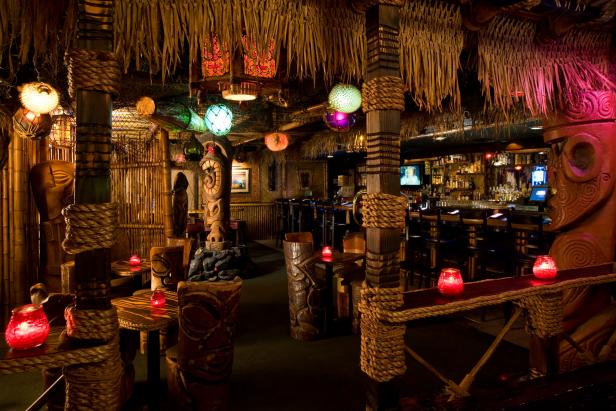Understanding Tiki Culture
Tiki culture, deeply rooted in Polynesian traditions, encompasses rituals, symbols, and art. Its profound impact on Western aesthetics, especially in surf decor, stems from intriguing history and symbolism.
Origins of Polynesian Tiki
Polynesians believed Tiki was the first man. Over centuries, diverse island cultures developed distinct Tiki representations. These statues, often carved from wood or stone, acted as spiritual vessels. They connected the mortal world with deities. Marquesas Islanders, for instance, crafted intricate Tiki poles to mark sacred spaces. In Hawaii, large temple Tikis conveyed power and protection.

Symbols and Deities
Each Tiki statue portrays specific gods or ancestral spirits. They hold symbolic meanings — fertility, protection, prosperity. For example, Tonga’s elongated figures symbolize ancestors. Maori Tiki, with its distinctive tongue, drives away evil spirits.
The Migration of Tiki Culture to Western Societies
Post-WWII, American soldiers returned with tales of the South Pacific. Western fascination with Polynesia grew. Tiki bars, with their exotic cocktails and decor, became urban escapes. Tiki culture's vibrant motifs, island aesthetics, and mystery found their place in American and European decor, especially coastal settings.
The Interconnection of Tiki and Surfing
Surfing and Tiki culture intertwine through shared Pacific origins. As surfing rode waves of popularity, Tiki aesthetics bolstered its iconic imagery.

The Surfing Boom in the '50s and '60s
Surfing's post-war explosion in California coincided with Tiki's rise. Beach movies, with their laid-back vibes, showcased Tiki motifs. This era, marked by The Beach Boys and Gidget, painted a romanticized view of the beach life. Tiki torches, statues, and themed parties flourished, solidifying the bond between surf culture and Polynesian aesthetics.
Tiki Bars and the Surf Lifestyle
Tiki bars became synonymous with the relaxed surf ethos. These tropical oases, adorned with bamboo, thatch, and Tiki statues, offered surfers a post-wave haven. Serving exotic concoctions like Mai Tais, they mirrored the adventurous spirit of wave riders.

Influence of Music: Surf Rock and Tiki Tunes
Music deepened the Tiki-surf connection. Surf rock, with its reverberating guitar riffs, drew inspiration from island rhythms. Bands like The Ventures and Dick Dale infused Tiki elements into their visuals and sounds. Vinyl covers featured Tiki statues, enhancing the genre's tropical ambiance.
Incorporating Tiki in Surf Decor
Tiki elements seamlessly meld with surf aesthetics, bringing authentic Polynesian flair to surf-inspired spaces. With rich history and symbols, Tiki deepens the surf narrative.
Tiki Statues and Surfing Spaces
Tiki statues, traditionally guarding sacred sites, now find prominence in surf-themed interiors. With carved details narrating Polynesian legends, they're more than mere decor. For instance, a Ku statue, representing the Hawaiian god of war, signifies protection, making it a favored choice near entryways.
The Trend of Tiki-Themed Surf Parties
Tiki-themed surf parties gained momentum in the '60s. They fused surf camaraderie with tropical vibes. Bamboo torches lit sandy shores, and surfboards rested against intricately carved Tiki totems. These gatherings weren't just about waves; they celebrated a blended culture.
Modern Interpretations of Tiki in Surf Decor
Today's designers reimagine Tiki in surf decor with a fresh lens. Traditional motifs merge with modern design principles. Sustainable materials and refined craftsmanship ensure cultural respect. Textiles, like Tiki-patterned cushions, blend seamlessly with minimalist surf interiors. Contemporary Tiki art, infused with vibrant colors and abstract forms, enlivens walls of chic coastal homes.

Tiki's Cultural Impact and Considerations
Tiki's influence on Western decor underscores deeper cultural dialogues. Its journey from sacred Polynesian emblem to global aesthetic demands thoughtful engagement and respect.
Cultural Appreciation vs. Appropriation
While Tiki’s influence on surf decor is undeniable, it’s crucial to discern appreciation from appropriation. Many Western Tiki adaptations, though well-intended, might inadvertently dilute its cultural significance. For instance, misrepresenting Tiki gods can be seen as disrespectful. Authentic engagement requires understanding, collaboration, and seeking consent from Polynesian communities.
The Role of Tiki in Modern Polynesian Societies
In Polynesia, Tiki remains a potent cultural symbol. Contemporary artisans still craft statues, infusing age-old techniques with modern inspirations. For Polynesians, Tiki statues aren't mere decor; they're ancestral links, narrating tales of gods, heroes, and epochs.
Sustainable and Respectful Tiki Decor Choices
Choosing Tiki decor demands responsibility. Authentic pieces, crafted by indigenous artisans, uphold traditions and offer economic support. Environmentally-friendly materials, like reclaimed wood or natural dyes, reflect both the respect for Polynesian culture and nature. Buyers should research, seek authenticity, and prioritize sustainable and community-centric choices.
The Lasting Legacy of Tiki in Surf Culture
Tiki's enduring legacy in surf culture goes beyond aesthetics. It's a fusion of histories, an interplay of cultures. With understanding and respect, Tiki's rich tapestry can continue to enhance surf spaces, while honoring its sacred Polynesian roots.
